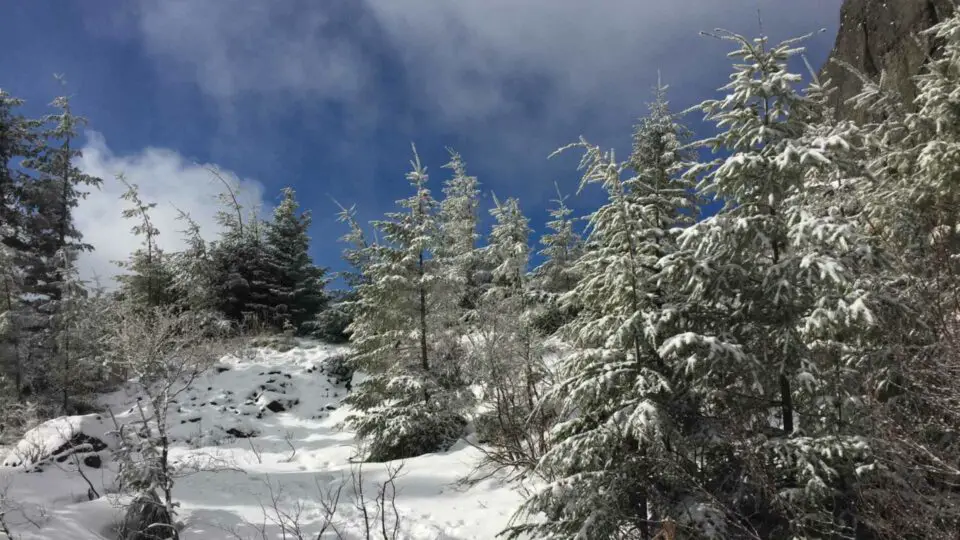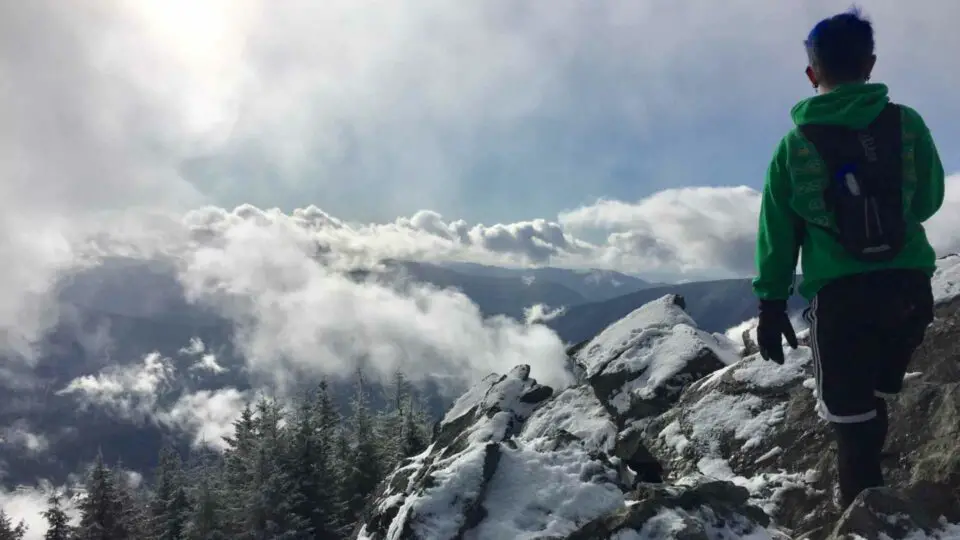Hiking Mount Si in the winter is very different from hiking Mount Si in the summer. The crowds have gone, the temps drop to single digits at the summit at night, the color scheme is white and gray, and you have to change what’s in your pack in order to have a safe trip.
Don’t underestimate winter at even a few thousand feet up. At 4167 feet, Mount Si is shorter than its neighbors to the east but tall enough to surprise flatlanders with severe weather up high. It’s usually among the last to get snow, but it definitely does get snow. It also usually melts out earlier, making it a spring favorite. The trail doesn’t cross any avalanche chutes so is a safe choice when those steep eastern neighbors are high-risk. The trail never becomes difficult to make out, even in several inches of snow, even if you’re the first one up after a big dump. But if you’re worried about navigation, just go a little later in the day and follow the bootpath. So really as far as winter hikes go, Si is gentle and kind. But it’s still winter in the mountains, and there are a few things you need to do differently than you do in summer:
What Gear Do I Need For Hiking Mount Si In The Snow?
The main areas you need to think of are staying warm, staying vertical, staying dry, and being able to see.
Warmth: With every 1000 feet of elevation you lose about 5 degrees of warmth. A typical winter day in western Washington might be like 45º at sea level, which puts you at 30º up top. Maybe you don’t need gloves to start, or feel fine in a long sleeve base layer and a light jacket, but try that outfit at 4000 feet and you’re going to be miserable. From about late September to May or so, I often have my Rab with me, my big puffy, my subzero beast, just in case. Also in my pack or on my body, depending: gloves, mittens, hand warmers, beanie, and one extra top layer aside from what I start in. You’d be shocked at how bitter cold it can get up high. Yes it might only be a three hour round trip, but you could also roll an ankle and be there for hours waiting for SAR, so now is the time to think about how comfortable you’d be if you had to spend an unexpected night on the mountain. Those mylar emergency blankets are cool. And if it’s going to be below 30º sustained, put your water in a Nalgene as your hydration bladder hose might freeze.
Staying Upright: Bring the appropriate form of traction for the conditions, which the vast majority of the time will be microspikes. Crampons would be overkill and snowshoes aren’t needed unless the snow has been substantial and recent, or if you plan to traverse over to Mount Teneriffe next door — the connector trail is not often used and gets deep snow. Poles for balance.
Staying Dry: If rain is anywhere near the forecast, bring a rain jacket and rain pants. If you have GoreTex footwear, now’s the time to wear them. Consider gaiters and extra socks.
Headlamp: I’ve been on my way down from Si at 2 pm in the winter and contemplated using my headlamp it was so dark. The sun sets by 4 and the forest is dense; a stormy midday summit that gives you plenty of light at the top can have it easily feeling like night once you get below treeline, which is like 95% of the hike. And don’t rely on your phone’s flashlight to give you enough light to hike safely on wet leaves or slick snow or ice. There’s no substitute for a good headlamp, and for the negligible number of ounces and space it takes up in your pack (or pocket for that matter) there is truly no excuse not to have one with you.
Checking Trail Conditions And Weather

The night before you go, check Washington Trails Association for the most recent trip reports, as they will give you the best, most up to date information about the conditions of the trail (fluffy snow, packed down snow, icy snow, melty slushy snow) and what gear was used. I normally have spikes in my pack every season but peak summer but I like to know what I’m getting into before I get there.
For weather, Mountain Weather Forecast is going to be your best source. Look at the hours and days after your planned hike. If a storm is on its way in, get an early start and be prepared to turn back if it blows in sooner than anticipated. Check up until you pull into the parking lot as weather changes constantly.
Other Considerations
- The parking lot never closes and some folks enjoy pre-dawn or post-dusk hiking, but be mindful of your own comfort zone when you plan what time of day you’re going.
- The absence of the summertime crowds give the mountain a very different vibe in winter. I enjoy the solitude as long as it’s light out; as soon as it’s dark and I’m alone I go into that weird hyperalert adrenaline mode, and while doable, it’s not my favorite. Know that places feel different in winter.
- Remember that it’s not off limits or scary, but don’t be cocky either: just be prepared. Adverse conditions are only a problem if you don’t have the right gear. If you have the means to stay warm and dry, and have traction so you don’t fall and a headlamp so you can see, there’s no reason you can’t enjoy the quiet serene beauty of Si when it’s wrapped in a blanket of glittery white snow. It’s quite magical really.
A Quick Recap Of The Gear List
- Headlamp
- Microspikes
- Trekking poles
- Parka
- Gloves
- Mittens
- Extra socks
- Hand warmers
- Extra top layer (fleece, jacket)
- Rain Jacket, rain pants if applicable

Wendy Harrington is a California native who has lived in a small town at the foothills of the Cascade Mountains in Washington state since 2001. Her love of trail running and peakbagging has led her to summit all five Washington volcanoes, climb to the high points of three states, and put nearly a thousand miles a year on her boots. Her loves include ridgelines, saddles, granite, one-day pushes on big mountains, anything volcanic, long solo days, and objectives that push limits and test endurance.

